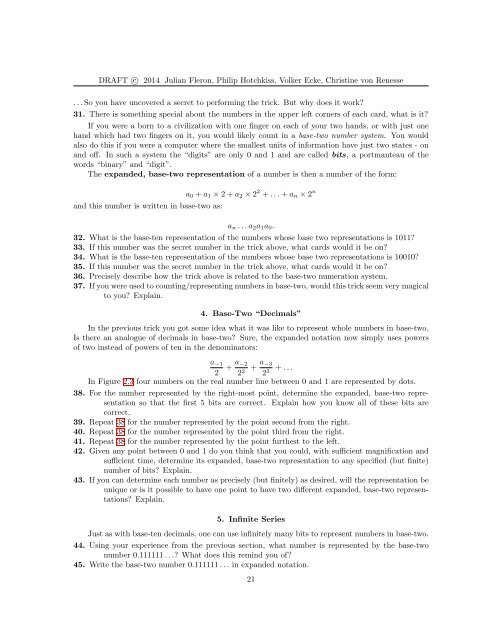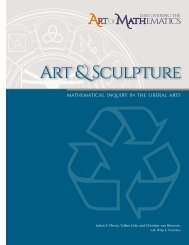calculus-2014-05-21
calculus-2014-05-21
calculus-2014-05-21
Create successful ePaper yourself
Turn your PDF publications into a flip-book with our unique Google optimized e-Paper software.
DRAFT c○ <strong>2014</strong> Julian Fleron, Philip Hotchkiss, Volker Ecke, Christine von Renesse<br />
. . . So you have uncovered a secret to performing the trick. But why does it work?<br />
31. There is something special about the numbers in the upper left corners of each card, what is it?<br />
If you were a born to a civilization with one finger on each of your two hands, or with just one<br />
hand which had two fingers on it, you would likely count in a base-two number system. You would<br />
also do this if you were a computer where the smallest units of information have just two states - on<br />
and off. In such a system the “digits” are only 0 and 1 and are called bits, a portmanteau of the<br />
words “binary” and “digit”.<br />
The expanded, base-two representation of a number is then a number of the form:<br />
and this number is written in base-two as:<br />
a 0 + a 1 × 2 + a 2 × 2 2 + . . . + a n × 2 n<br />
a n . . . a 2 a 1 a 0 .<br />
32. What is the base-ten representation of the numbers whose base two representations is 1011?<br />
33. If this number was the secret number in the trick above, what cards would it be on?<br />
34. What is the base-ten representation of the numbers whose base two representations is 10010?<br />
35. If this number was the secret number in the trick above, what cards would it be on?<br />
36. Precisely describe how the trick above is related to the base-two numeration system.<br />
37. If you were used to counting/representing numbers in base-two, would this trick seem very magical<br />
to you? Explain.<br />
4. Base-Two “Decimals”<br />
In the previous trick you got some idea what it was like to represent whole numbers in base-two.<br />
Is there an analogue of decimals in base-two? Sure, the expanded notation now simply uses powers<br />
of two instead of powers of ten in the denominators:<br />
a −1<br />
2 + a −2<br />
2 2 + a −3<br />
2 3 + . . .<br />
In Figure 2.3 four numbers on the real number line between 0 and 1 are represented by dots.<br />
38. For the number represented by the right-most point, determine the expanded, base-two representation<br />
so that the first 5 bits are correct. Explain how you know all of these bits are<br />
correct.<br />
39. Repeat 38 for the number represented by the point second from the right.<br />
40. Repeat 38 for the number represented by the point third from the right.<br />
41. Repeat 38 for the number represented by the point furthest to the left.<br />
42. Given any point between 0 and 1 do you think that you could, with sufficient magnification and<br />
sufficient time, determine its expanded, base-two representation to any specified (but finite)<br />
number of bits? Explain.<br />
43. If you can determine each number as precisely (but finitely) as desired, will the representation be<br />
unique or is it possible to have one point to have two different expanded, base-two representations?<br />
Explain.<br />
5. Infinite Series<br />
Just as with base-ten decimals, one can use infinitely many bits to represent numbers in base-two.<br />
44. Using your experience from the previous section, what number is represented by the base-two<br />
number 0.111111 . . .? What does this remind you of?<br />
45. Write the base-two number 0.111111 . . . in expanded notation.<br />
<strong>21</strong>



